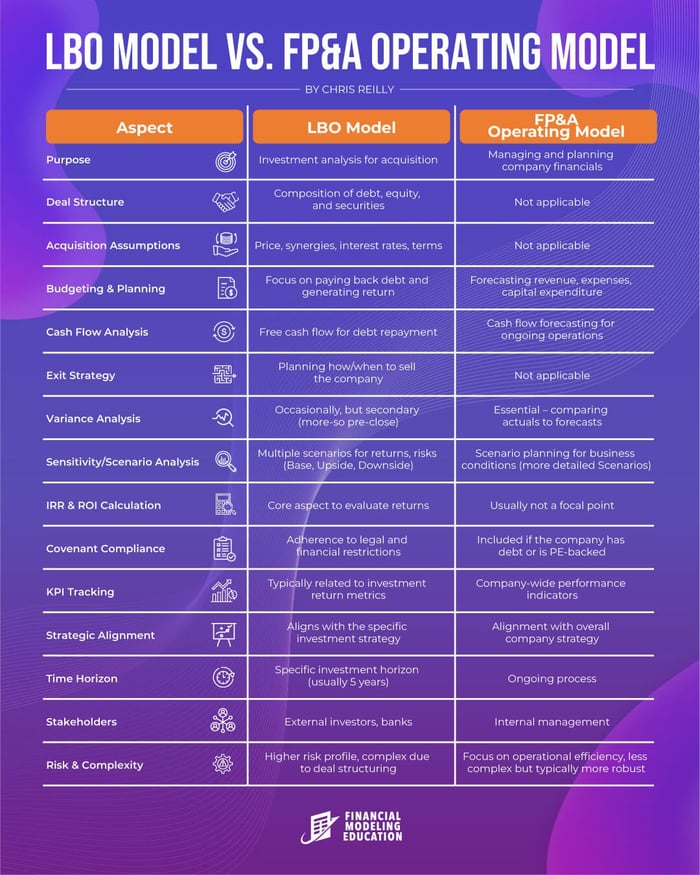Here are the primary differences between an LBO Model and FP&A Model...
LBO Model
Often complicated in its structure, an LBO Model is shorter-term in nature in terms of its overall shelf life.
Its primary use is to figure out if buying a company is a good idea, mainly by assessing how much debt a company can handle and what the corresponding returns might be.
The primary inputs revolve around debt load assumptions (i.e., multiples of EBITDA), interest rates, and debt tranches (senior, mezzanine, unitranche, or seller financing).
This is because (in theory) the more leverage you use, the greater the returns can be for the equity holders. But, the portfolio company has to be able to sustain the debt amount.
So, you need to factor in meaningful downside scenarios as well, else the company can easily drift into default (been there).
Big picture: can/should we buy this thing or not? If so, how much debt can it meaningfully handle so we're not underwater but can also generate a nice return.
FP&A Model
An FP&A Model, on the other hand, is a planning tool companies use to manage their core operations.
Often built with much more operating detail, the FP&A Model is used to create Budgets and Forecasts (which are different things), and also serves as a reporting tool comparing Actuals to Budget.
This model has a much longer shelf life and is updated on a recurring basis.
You'll have detailed schedules for nearly every line item, a full company "census" (list of employees), and more reporting metrics.
I like my layout to be something like this:
- Raw Data (from accounting system)
- Support Schedules
- Three Statement Model
- Flash Reports / short-term summaries
- Monthly Reporting
- Quarterly Reporting (for the Board)
The only things that should change month-to-month are the Raw Data (as new Actuals come in) and the Support Schedules if we're building a "Rolling Forecast."
Everything else should be left alone. I don't want to see any "topside" adjustments, aka the Managing Partner just hard-coding a bunch of stuff in my Quarterly Summary. That's a recipe for error.
It's on the modeler to make it clear what you can "play with" and what you leave alone.
Can LBO Models Become FP&A Models?
Sometimes, sure. But most often what happens is a "fresh rebuild" of the FP&A Model after the deal has closed.
This is because the core functionality of the LBO Model (buying the company and adjusting the balance sheet) is no longer needed, so you're keeping a lot of obsolete complexity in your file that will ultimately bog down the forthcoming FP&A detail.
Also, things like Returns Analysis isn't overly helpful in the FP&A setting, as many people at the portfolio company will likely be looking at the model. So, it's best to keep those metrics at the "PE level" once the deal is done.
I Do Two Things
(well, it's more like three now)
- Financial Modeling Email series: everything I've ever known about modeling, Private Equity, & FP&A crammed together in a free weekly series, comes out on Tuesdays.
- Financial Modeling Courses: self-study as recognized by LinkedIn Learning and the Wharton Online Private Equity Certificate Program.
- FP&A/M&A Consulting work for mid-market companies.
Until next time.
—Chris

